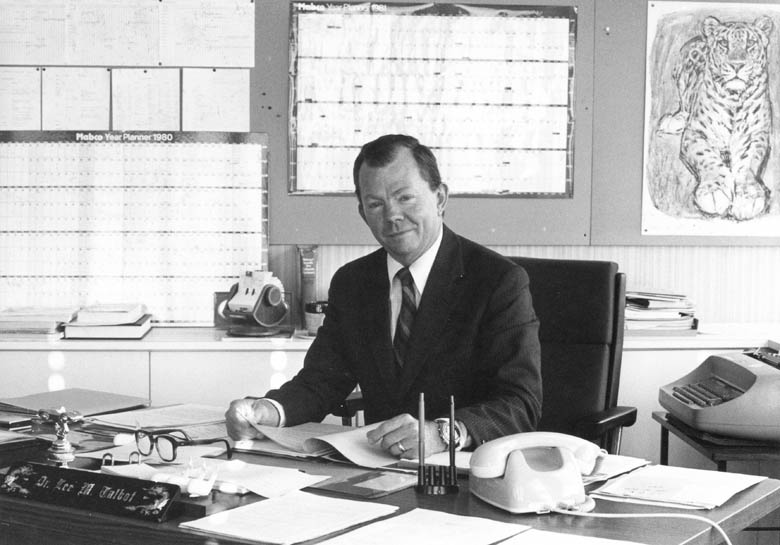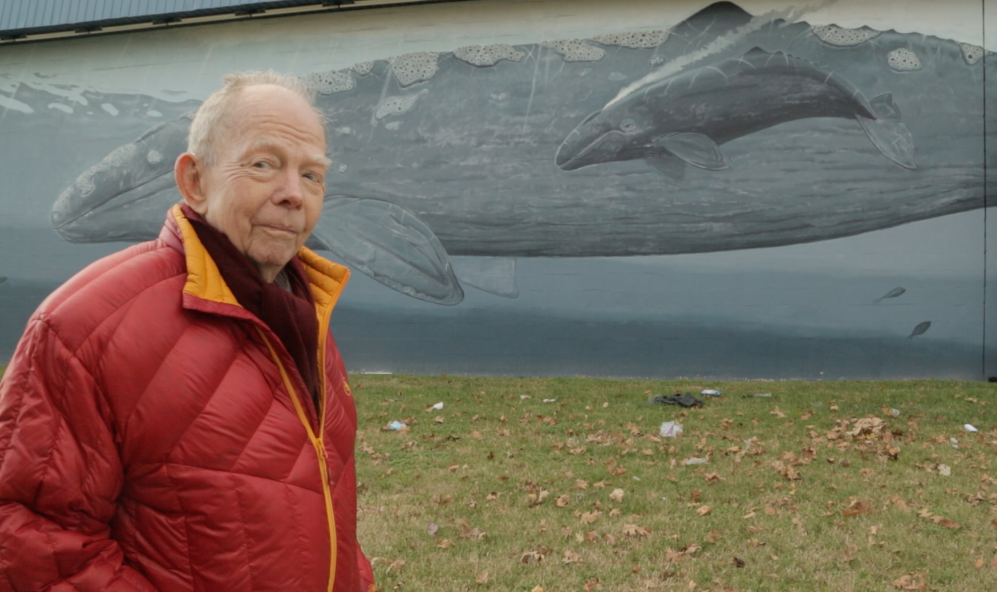A tribute to Lee Merriam Talbot (1930 – 2021)
IUCN is deeply saddened by the passing of its former Director General, Lee Merriam Talbot. A lifelong conservation champion, Lee is remembered in the personal tribute below by Russell Mittermeier, Chief Conservation Officer at Re:wild (formerly Global Wildlife Conservation) and Chair of the IUCN SSC Primate Specialist Group.
I was very sad this past week to learn of the passing, on April 27, of one of our greatest conservation pioneers and my very dear friend, Lee Merriam Talbot. I first met Lee when he was Director General of IUCN (1980-1982) and I was just starting as a member of IUCN’s Species Survival Commission Steering Committee. I was immediately impressed by his charm, his good nature, and the depth of his knowledge of conservation issues, and we struck up a friendship that lasted 40 years.
However, I already knew about Lee way before that first meeting, having read some of the ground-breaking publications from his early work in the 1950s in Kenya and Tanzania (then still Tanganyika) back when I was an undergraduate at Dartmouth College in the late 1960s. These important studies showed how the diverse array of native ungulate species used the available resources much more efficiently than cattle, and this work contributed significantly to the creation of Tanzania’s Serengeti National Park and Kenya’s Masai Mara National Reserve.
Over the years, he and his wife Marty spent long periods of time assessing the status of species in many parts of Africa and Asia, again contributing to the creation of protected areas as diverse as Australia’s Great Barrier Reef Marine Park and India’s Gir National Park, the home of the Asiatic lion. Most recently he and Marty dedicated a lot of time working in Laos, continuing to do active field work well into their 80s.
Aside from his role as an IUCN Director General, Lee had many other major impacts in the early days of conservation in the latter half of the 20th century. During his time as a senior US Government official, he was a primary architect of the U.S. Endangered Species Act (ESA) and the Marine Mammal Protection Act (MMPA), and played very important roles in the adoption of the Convention on Trade in Endangered Species of Wild Fauna and Flora (CITES), and the UNESCO World Heritage Convention.
He served as Senior Scientist and Director of International Affairs of the Council of Environmental Quality (CEQ) under Presidents Nixon, Ford and Carter. Another little-known fact is that he ran the Office of Ecology for the Smithsonian Institution’s National Museum of Natural History in Washington, D.C. from 1965 to 1968, which provided support for a number of early researchers. In the last phase of his career, he taught Environmental Science and Policy and advised graduate students at George Mason University in northern Virginia, a post that he occupied for 29 years.
His publications include more than 300 scientific and popular articles and 17 books. His first book, published in the UK in 1960, was entitled “A Look at Threatened Species,” and many of his later works also focused on endangered species and their role in broader conservation issues. His career took him and Marty to more than 130 countries across the world, often in the role of advisor to governments and NGOs.
What many in conservation might not know about Lee is that he also loved car racing, not the usual fare for people in our business. He was 18 when he entered his first professional race in 1948, and he was 87 when he raced for the last time in 2017, a remarkable racing career of 69 years! He not only competed in, but often won, races in many different kinds of vehicles and at a wide variety of venues.
When I look back at my long relationship with Lee, I am proudest of what we managed to put together on behalf of our close friend, and perhaps the most influential of all the early conservation pioneers, Dr. Harold Jefferson Coolidge. Both Lee and I had long relationships with Hal, who was one of the founders of IUCN, the first Chair of the Species Survival Commission, and a very early field researcher who carried out studies of primates and ungulates (especially the Kouprey) in Southeast Asia, gorillas in Africa, and many other species. Without Hal and his support as the principal fundraiser for IUCN from 1948 to the 1980s, IUCN might not have made it through its first few decades.
About 20 years ago, Lee and I became very concerned that Hal’s importance to IUCN was starting to be forgotten, and we conspired to create an award in his name. We both supported this financially and convinced IUCN that it was an absolute necessity, with the result that the Union created the Harold Jefferson Coolidge Memorial Medal and awarded it for the first time at the 2008 World Conservation Congress in Barcelona.
The first recipient was Dr. Robert Goodland, for decades the voice for conservation at the World Bank, followed by Dr. Wolfgang Burhenne, the long-time Chair of the IUCN Commission on Environmental Law, who received it at the World Conservation Congress in Jeju, South Korea in 2012. The last medal was awarded at the 2016 Congress in Hawaii, and I was delighted and honored to be able to make the presentation to none other than Lee Merriam Talbot himself.
Lee was also the grandson of the renowned American zoologist C. Hart Merriam, considered by many to be “the Father of American mammalogy” and also a major figure in American ornithology. Among many other major contributions, Merriam was the founder of the U.S. Biological Survey, which eventually became the U. S. Fish and Wildlife Service. This relationship is reflected in Lee’s middle name and also in the middle name of his son Rusty and grandson Jack.
One of Lee’s sons, Rusty, described him in his obituary for the Explorer’s Club Washington Group as “a truly towering figure… an amalgamation of the best aspects of John Muir, Ernest Hemingway, and James Bond, but .… humbler and, arguably, more influential than any of these characters.” Another great conservation pioneer, Dr. Thomas E. Lovejoy, when describing Lee’s career, said, “If you want to know why species like tigers and gorillas and rhinos and African elephants are still roaming the wild, here’s why…”. Lovejoy also said that it was hard to imagine a life that he didn’t touch. I can’t do better than that. All I can say is that he was a wonderful loyal friend for many, many years and that I, and the entire global conservation community, will miss him very much.
Lee was 90 at the time of his passing. He is survived by Marty, his wife of nearly 62 years, their sons Lawrence and Rusty, two grandchildren, Jack and Ryder, and his sister Zenaida Mott.
Russell A. Mittermeier, Chief Conservation Officer, Re:wild (formerly Global Wildlife Conservation); Chair, IUCN SSC Primate Specialist Group; and Honorary Member, IUCN.
IUCN invites anyone who would like to pay tribute to Lee to add a few words in the comments below.






Lee Talbot
I had the immense pleasure of meeting Lee Talbot at the IUCN World Conservation Congress in Hawaii, when he was awarded the Harold Jefferson Coolidge Memorial Medal. A really delightful person! Thank you Lee for your words of encouragement in the preparations of the Congress; your words resonate now that we are preparing for Marseille. And thank you for your significant contributions to conservation.
The enormous contribution of Lee Talbot
With the passing of Lee Talbot, it feels as if an era has come to an end. He was the last person who worked with the visionaries who founded what became the IUCN Species Survival Commission (SSC). In the early 1950s, the SSC wanted to know what was happening to the conservation of species across the globe, especially in the tropics. This was a different world from now. Information was hard to come by and did not flow quickly or easily. So the SSC commissioned a young ecologist, Lee Talbot, to travel to some of the most important wildlife havens in the world to find out what was happening to the species, and how effective conservation measures were. Though few people know it today, the information he collected, and the reports that he wrote provided the factual underpinning on which the modern worldwide conservation movement was built. A decade or so ago, Lee and I had a a discussion in the Cosmos Club in Washington DC at which we came up with the idea that he revisit some of the sites he had visited in the 1950s, and report back on how things had changed in the intervening 60+ years. He was keen on the idea, and we even toyed with the idea of of getting a major media company involved. But unfortunately both of us were too busy to turn this idea into reality - a shame, because hearing Lee talking about the progress of conservation in particular places over many decades would have been absolutely fascinating.
My good friend Russ Mittermeier has written a perfect summary of Lee above which captures the essence of the man. He was very courteous in an old-fashioned sort of way, and yet he spoke his mind, often with great humour. And Marty was always at his side - they were the perfect team. Lee always seemed so healthy, and so his passing came as a surprise to me and many others, even despite his long life. Thanks Lee for modelling humble leadership. You never sought attention for yourself - your focus was on the conservation cause itself. What an example!
Lee Talbot
Lee Talbot's life encompassed the history of modern conservation, from its beginnings in the first tentative exploration of wild nature to the global endeavor that it is today. In the early 1960s, Lee was on the first biologists to venture into the field to describe the abundance and diversity of wildlife populations. In the first half of that decade, with grants from the New York Zoological Society, Lee undertook the first studies of East African wildlife communities. Going on to become the Director General of IUCN he took that knowledge of nature and used it to inform how IUCN would evolve into its role in the conservation community. I first met him at that time, and over the years, Lee was a constant source of inspiration and encouragement. What a wonderful and generous man. He will be missed.
Lee's extraordinarily diverse
Lee's extraordinarily diverse life prepared him perfectly for a vital and demanding role he played for the last couple of decades - as the biodiversity member of the International Panel of Social and Environmental Experts for Lao PDR's Nam Theun 2 hydropower project. The PoE was the primary force responsible for some major threats to the catchment's habitat and wildlife being averted - no NGO or even government technical department could have managed this. While it is too early to be sure what the final effects of the project on its surrounding habitat and wildlife will be, the PoE, through Lee, bought precious time for the system to 'learn by doing', through prevention of the loss of options early on. This gave the NT2 project's ambitious compensatory programme for the conservation of the catchment's wildlife and habitat the best possible chance to succeed. This is not something to be taken for granted: without Lee's diligence, hard work, and lengthy, regular discussions in the Prime Minister's Office (perhaps my number 1 'fly on wall' wish), fewer pieces would have survived to work with.
Lee`s contribution to Canada
I met Lee Talbot through his wife Martha. I had met Elizabeth Cushman and Martha at Yale in 1955 in my role as President of the Yale Forestry Society, a role that required that I greet all visitors at the Yale School of Forestry. They were my first visitors as they were working on their graduating thesis proposing student summer internships in a conservation service for the National parks Service. When I last checked with Elizabeth in Boston 62,500 students had benefitted from participation.
Martha and I kept in touch for years and we both married our respective spouses in 1959 when I married Elisabeth von Bandian of Vienna Austria. The foursome kept in contact during our travels and professional work. In 1971 during a 12 week senior management course in the Government of Canada I found myself in an 8-person syndicate with the charge to draft a Canadian Environmental Impact Assessment Policy and Procedure drawing on a ton of help from our client who was a friend and Assistant Deputy Minister of the new Department of the Environment. Eight weeks later we presented our results and an officer from Treasury Board who spoke to us beside our flip charts said, "Gentlemen, that was the best problem analysis I have ever heard. Shortly thereafter the ADM hired me to head up a Canadian Task Force on EIA. One of my first recommendations was that we call Lee Talbot at the Council on Environmental Quality and see about an immediate visit to Washington to see what the government did to itself when it created the National Environmental Policy Act one year earlier. I called Lee and this is what he said right away. "Pat, can you bring your team to D.C. early next week and I will have all of your contacts ready to see you, and more". We went through government like a vacuum cleaner and came up with a Cabinet Policy which morphed into an Act in 1996 after years of massaging. Our debt to Lee Talbot was huge.